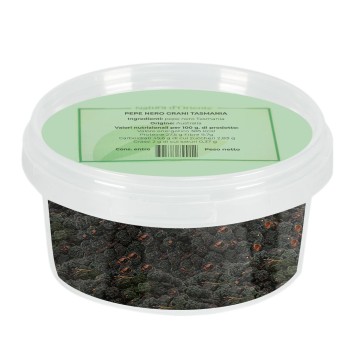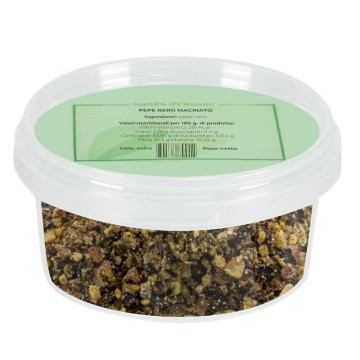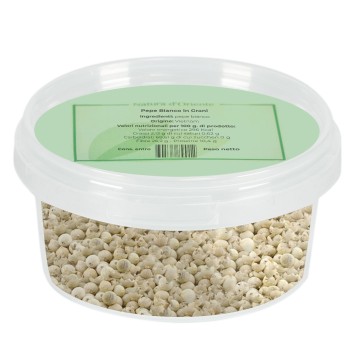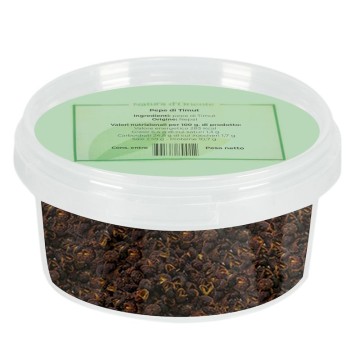Cubeb pepper is a relative of the classic black pepper, it belongs to the same botanical genus, Genus piper, and the appearance of the small fruits is very similar. The taste is aromatic and bitter but more delicate so it lends itself to combinations with delicate dishes.
The plant and the fruit
Cubeb pepper is the fruit of a plant of the Piperaceae family called Piper Cubeba. The plant is a climber (like the Piper Nigrum) that can reach considerable heights (up to six meters), even the leaves are quite similar, oval and elongated, only a little narrower. The wrinkled berries are gathered in inflorescences, the biggest difference is the petiole which often remains attached to the berries even after drying and can be found on the market with the petiole still attached. So much so that this spice is sometimes also called pepper with a tail. Inside it contains only one oily white seed. As for the preparation of black pepper, the fruits are harvested before ripening when they are still green following drying and darken (just like black pepper), sometimes the color they take is more gray than black and in fact the cubeb sometimes it has also been called gray pepper.
Place of origin and cultivation
Well we wrote it in the title, the cubeb pepper is also called Java pepper but it seems that this is not the place of origin but Indonesia and in reality it is widespread throughout Southeast Asia: Vietnam, Indonesia, Burma, Sunda Islands, but it grows naturally and is mainly cultivated in Java and Sumatra. So why is it known as Java pepper? Known since ancient times, in the Greek world Theophrastus mentions it, who calls it komakon, later deepening the etymology of the word it was discovered that it probably derives from the Javanese "kumkus", therefore it was probably introduced in the West as a result of contacts between the Greeks and the Javanese. in the past and throughout the Middle Ages it enjoyed a certain popularity, also because it was cheaper than black pepper which was a very expensive spice. The decline began due to the boycott of the king of Portugal who wanted to impose black pepper which in the meantime had dropped in price thanks to the new routes opened by the explorations of the 1600s. It is currently also cultivated in Africa, particularly in Sierra Leone and Congo.
Properties of the cubeb pepper
Some of the properties attributed by traditional medicine to cubeb pepper are the same or similar to those attributed to pepper, ie diuretic and antiseptic properties of the urinary tract. A particular medicinal use of cubeb pepper is instead that due to the balsamic and expectorant properties that are recognized, the use of cubeb cigarettes as a treatment for asthma, pharyngitis and allergic rhinitis survived until a long time ago, during the Second World War they were still produced.
As usual: nutritional properties are not worth talking about, not because they don't have them, but because they are insignificant for the quantities used in the case of spices.
Curiosities about Cubebe pepper
About cigarettes for asthma: Edgar Rice Burroughs, American novelist known for being the creator of the character of Tarzan, was an avid consumer, even joking that without they would not have been Tarzan.
In the famous collection "The Thousand and One Nights", the cubeb pepper is mentioned as a remedy for infertility.
In Morocco it is widely used in confectionery often candied with sugar or tamarind glaze.
In Southeast Asian cuisine it is an ingredient in many masala (spice mix).
In addition to its use as a spice, an essential oil is obtained that is rich in antioxidant properties but which should not be used pure to avoid the risk of dermatitis or irritation. In cosmetics it is used for the preparation of anti-wrinkle products.
As we said in Europe now cubeb pepper is not very widespread, but it was before 1600, in Poland in the 14th century it was used to marinate meat with a condiment called Ocet Kubebowy. This dressing was made from vinegar infused with cubeb pepper, cumin and garlic.
In ancient times Javanese growers sterilized berries so that the plant could not be introduced elsewhere.
Cubeb pepper in the kitchen
The flavor is defined by some as a cross between a more delicate aromatic black pepper and allspice others combine it with juniper berries or cloves due to its balsamic aroma .
This relative delicacy favors use in dishes with a delicate flavor but also combinations with chocolate and use in pastry. Someone suggests trying it in prosecco. We just gave in to the throat this time by selecting from the many recipes found on the net, we chose:
Pear and chocolate cubeb pepper jam
Ingredients
- 1 kg of leg pears (or alternatively of abate pears)
- 250 grams of cane sugar
- juice of 1/2 lemon
- 150 gr of extra dark chocolate (at least 70% cocoa)
- 6 cubeb pepper berries
Preparation
Please note: this recipe needs two days
First day:
1) Cut the pears into small pieces and put them in a saucepan with the sugar and lemon juice.
2) Put the saucepan on the stove and bring to a boil.
3) Cook for 5 minutes from when it starts to boil.
4) Remove the pan from the heat and add the chopped chocolate, mixing well until it melts completely.
5) Leave to cool completely and place the pot in the refrigerator overnight with the lid on.
Second day (next morning):
1) Remove the pan from the fridge and put it back on the heat, over low heat, bringing it back to a simmer.
2) Let it cook for 30-35 minutes, stirring with a wooden spoon from time to time.
3) In the meantime, lightly toast (for a few minutes) the pepper berries in a small pan, then put them in a mortar and crush them until they are reduced to a powder.
4) Add the pepper to the jam and mix well with a spoon.
5) Pour the jam while still hot into sterilized jars and close tightly with a sterilized cap.
6) Turn the jars upside down, cover them with a tea towel and allow to cool completely.
Recipe source: Saygood.it

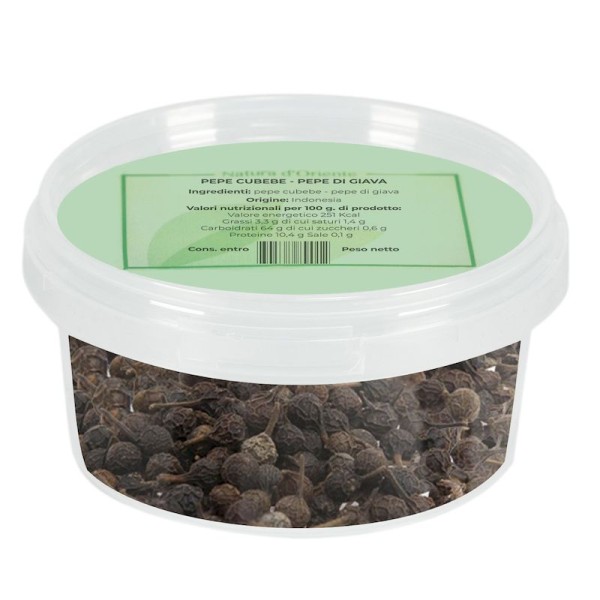







 No reward points for this product.
No reward points for this product.
